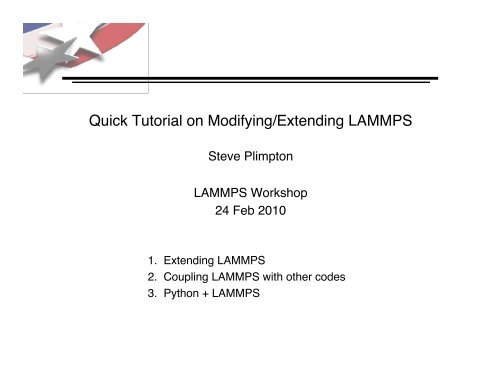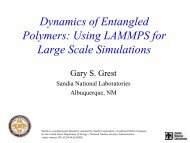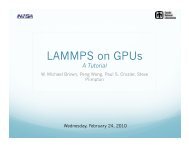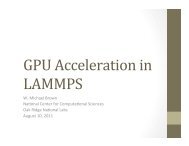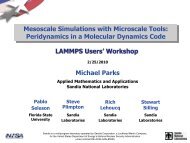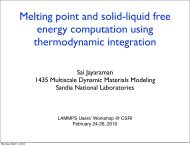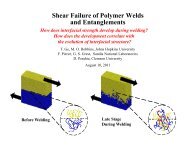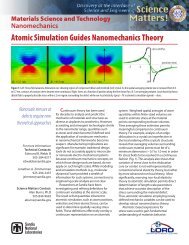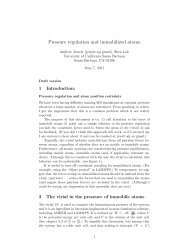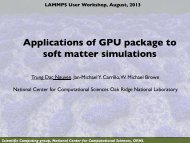How to modify LAMMPS to meet your own needs
How to modify LAMMPS to meet your own needs
How to modify LAMMPS to meet your own needs
You also want an ePaper? Increase the reach of your titles
YUMPU automatically turns print PDFs into web optimized ePapers that Google loves.
Quick Tu<strong>to</strong>rial on Modifying/Extending <strong>LAMMPS</strong>Steve Plimp<strong>to</strong>n<strong>LAMMPS</strong> Workshop24 Feb 2010 1. Extending <strong>LAMMPS</strong> 2. Coupling <strong>LAMMPS</strong> with other codes 3. Python + <strong>LAMMPS</strong>
Extending <strong>LAMMPS</strong> via Styles• In hindsight, this is best feature of <strong>LAMMPS</strong>80% of code is “extensions” via stylesonly 35K of 175K lines is core of <strong>LAMMPS</strong>• Easy for us and others <strong>to</strong> add new features via 14 “styles”new particle types = a<strong>to</strong>m stylenew force fields = pair style, bond style, angle style, dihedral style, improper stylenew long range = kspace stylenew minimizer = min stylenew geometric region = region stylenew output = dump stylenew integra<strong>to</strong>r = integrate style new computations = compute style (global, per-a<strong>to</strong>m, local)new fix = fix style = BC, constraint, time integration, ...new input command = command style = read_data, velocity, run, ...• Enabled by C++virtual parent class for all styles, e.g. pair potentialsdefines interface the feature must providecompute(), init(), coeff(), restart(), etc
<strong>How</strong> <strong>to</strong> Add a Feature as a new Style• Details are in doc/Section_<strong>modify</strong>.html• Create a new class (*.cpp and *.h) filederive from parent virtual classe.g. RegTriangle class from Region classprovide the various methods the interface requires• Put these lines in header file: (no longer necessary <strong>to</strong> edit style.h)#ifdef REGION_CLASSRegionStyle(triangle,RegTriangle)#else... (usual class header info)#endif• Drop 2 files in src dir, re-compile <strong>LAMMPS</strong>• Pres<strong>to</strong>: <strong>your</strong> input script can use “region_style triangle” comand
Example: RegTriangle class• 25 lines of code (leaving out 2 methods)• construc<strong>to</strong>r (int narg, char **arg)reads arguments: x1 y1 x2 y2 x3 y3determines extent = bounding box• inside (double x, double y, double z):determine if (x,y) is inside triangle (2d only)3 positive cross products inside
egion_triangle.h#ifdef REGION_CLASSRegionStyle(triangle,RegTriangle)#else#include "region.h"namespace <strong>LAMMPS</strong>_NS {class RegTriangle : public Region {public:RegTriangle(class <strong>LAMMPS</strong> *, int, char **);int inside(double, double, double);int surface_interior(double *, double);int surface_exterior(double *, double);private:double x1,y1,x2,y2,x3,y3;};}#endif#endif
egion_triangle.cppRegTriangle::RegTriangle(<strong>LAMMPS</strong> *lmp,int narg, char **arg) :Region(lmp, narg, arg){options(narg-8,&arg[8]);// inside = 1 if x,y,z is inside or onsurface// inside = 0 if x,y,z is outside and no<strong>to</strong>n surface}x1 = xscale*a<strong>to</strong>f(arg[2]);y1 = yscale*a<strong>to</strong>f(arg[3]);x2 = xscale*a<strong>to</strong>f(arg[4]);y2 = yscale*a<strong>to</strong>f(arg[5]);x3 = xscale*a<strong>to</strong>f(arg[6]);y3 = yscale*a<strong>to</strong>f(arg[7]);extent_xlo = MIN(x1,x2);extent_xlo = MIN(extent_xlo,x3);extent_xhi = MAX(x1,x2);extent_xhi = MAX(extent_xhi,x3);extent_ylo = MIN(y1,y2);extent_ylo = MIN(extent_ylo,y3);extent_yhi = MAX(y1,y2);extent_yhi = MAX(extent_yhi,y3);extent_zlo = -0.5;extent_zhi = 0.5;int RegTriangle::inside(double x, double y, double z){double side1 = (x-x1)*(y2-y1) – (y-y1)*(x2-x1);double side2 = (x-x2)*(y3-y2) – } (y-y2)*(x3-x2);double side3 = (x-x3)*(y1-y3) – (y-y3)*(x1-x3);if (side1 > 0.0 && side2 > 0.0 && side3 > 0.0) return 1;return 0;
Friction Example: examples/frictionexamples/friction/in.frictionReplace: region lo-asperity sphere 32 7 0 8 region hi-asperity sphere 18 15 0 8With: region lo-asperity triangle 26 7 32 14 38 7 region hi-asperity triangle 12 15 24 15 18 8If added surface_interior() andsurface_exterior()could have triangular-shaped containervia walls, triangular obstacles in flow,triangular indenter, etc
Computes• Computes are used <strong>to</strong> calculate instantaneous quantities:global scalar or vec<strong>to</strong>r or arrayper-a<strong>to</strong>m scalar or vec<strong>to</strong>rlocal vec<strong>to</strong>r or array• Their results are s<strong>to</strong>red, so can be accessed by otherfixes, computes, variables, thermo output, dump files• Computes can s<strong>to</strong>re old per-a<strong>to</strong>m info by using a fix, e.g. compute msd• Computes can use neighbor lists, e.g. compute group/group• New per-molecule computes, e.g. compute msd/molecule• See doc/compute.html for details (~40 of them)
Fixes are most powerful, flexible Style• Define particle attributes mass, x, v, f, charge, bonds, angles, orientation, <strong>to</strong>rque, dipole, shear his<strong>to</strong>ry, ...• Loop over timesteps:fix_initial NVE, NVT, NPT, rigid-body integration communicate ghost a<strong>to</strong>msfix_neighbor insert particlesbuild build neighbor list list (once (once in in a while) while)compute forces forcescommunicate ghost ghost forces forcesfix_force SHAKE, langevin drag, wall, spring, gravityfix_final NVE, NVT, NPT, rigid-body integrationoutput fix_end<strong>to</strong> screen and files volume & T rescalingoutput <strong>to</strong> screen and files• Fixes can operate on sub-groups of a<strong>to</strong>ms, add per-a<strong>to</strong>m s<strong>to</strong>rage,communicate, write status <strong>to</strong> restart file, ... see doc/fix.html for details (75)
Coupling <strong>LAMMPS</strong> <strong>to</strong> Other Codes• <strong>LAMMPS</strong> can be built as library, instantiated many times• Method 1: MD is the driverMD FEenabled by fixes, link <strong>to</strong> external librarycoupled rigid body solver from RPI• Method 2: Other code is the driverFE MDbuild <strong>LAMMPS</strong> as a librarycall from C++, C, Fortran, Pythonlow-overhead <strong>to</strong> run MD in spurtsinvoke low-level ops (get/put coords)• Method 3: Umbrella code is the driverUmbrella code calls MD and FEcould run <strong>LAMMPS</strong> on P procs, FE on Q procs, talk <strong>to</strong> each otherweʼre linking <strong>LAMMPS</strong> <strong>to</strong> a MC Potts code for stress-driven grain growth• Challenge: balance the computation so both codes run efficiently in parallel
Python wrapping of <strong>LAMMPS</strong>• Use Python ctypes (2.5 or later) <strong>to</strong> wrap C-interface in src/library.h• Build <strong>LAMMPS</strong> (and MPI, FFTW, etc) as shared library via setup.py• Can instantiate one or more <strong>LAMMPS</strong>:invoke <strong>LAMMPS</strong> scripts or commands from Pythongrab/change a<strong>to</strong>m coords or other properties, etc>>> from lammps import lammps>>> lmp = lammps(sys.argv)>>> lmp.file(“in.lj”)>>> lmp.command(“run 1000”)>>> del lammpsdef file(self,file):self.lib.lammps_file(self.lmp,file)def command(self,cmd):self.lib.lammps_command(self.lmp,cmd)• Extend by adding <strong>to</strong> 2 files: src/library.cpp and python/lammps.py• Could wrap <strong>LAMMPS</strong> in a GUI or do Python-based viz• Can run in parallel, if <strong>your</strong> Python is extended with MPI (e.g. PyPar)


